Aussie deer
by John Dunn
Had the people involved in acclimatisation been as successful as they hoped they might be, there is no doubt we’d have a lot more game species living in Australia today. Between 1860 and 1900, the Acclimatisation Society of Victoria was responsible for the importation of no less than 26 species of deer - all intended for liberation.
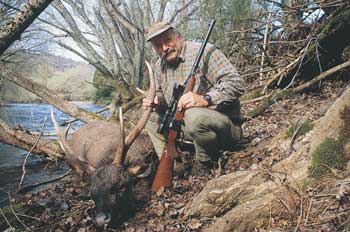 History records that many species never made it to the liberation stage
and some of those that did failed to survive in the wild. Yet the
legacy of the acclimatisation era remains and today at least seven
species of deer are established as wild populations in Australia - and
there may well be others. Some are the descendants of original releases
that have extended their range, while others have always had a limited
distribution. In many areas, recent populations have been established
by escapees from modern deer farming enterprises or as clandestine
releases. Regardless of their origins, there are more deer in Australia
in the 21st century than there ever have been before - a situation that
increasing numbers of hunters are learning to appreciate.
History records that many species never made it to the liberation stage
and some of those that did failed to survive in the wild. Yet the
legacy of the acclimatisation era remains and today at least seven
species of deer are established as wild populations in Australia - and
there may well be others. Some are the descendants of original releases
that have extended their range, while others have always had a limited
distribution. In many areas, recent populations have been established
by escapees from modern deer farming enterprises or as clandestine
releases. Regardless of their origins, there are more deer in Australia
in the 21st century than there ever have been before - a situation that
increasing numbers of hunters are learning to appreciate.
Sambar deer (Cervus unicolour)
Sambars are our premier game animal - arguably a world-class deer
species and undoubtedly the greatest challenge a hunter will ever take
up in mainland Australia.
They arrived here in the mid 1800s and were subsequently released at various locations in Victoria and on the Coburg Peninsular in the Northern Territory. Today they are the mainstay of Victorian deer hunters, the majority of animals living along the Great Dividing Range in eastern Victoria and penetrating well into southern NSW.
Sambars are a large animal. A big stag may weigh 220 kilograms or more and stand 125cm at the shoulder. They’re generally brown but lighter grey or very dark animals may also be encountered. Their under parts are generally a lighter, old straw colour and the tail is fringed with orange hairs. Though rather dull-colored when compared to other species, the sambar blends remarkably well into the Australian mountain forests.
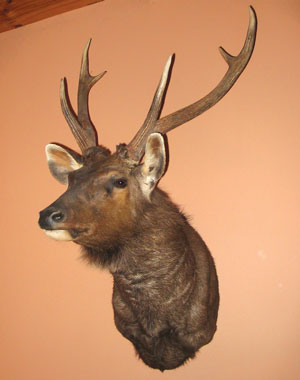 Though they graze when it suits them, sambar are essentially a browsing
animal, feeding on a wide range of both native and introduced plants. A
basic knowledge of the plants they use is essential knowledge for every
sambar hunter as it is one of the keys to finding the best hunting
areas.
Though they graze when it suits them, sambar are essentially a browsing
animal, feeding on a wide range of both native and introduced plants. A
basic knowledge of the plants they use is essential knowledge for every
sambar hunter as it is one of the keys to finding the best hunting
areas.
Sambar antlers are typically six-pointed with a brow, inner and outer top tine on either side. The conformation is V-shaped, ranging from quite narrow to overspread, relative to the length of the antlers. Given the difficulties involved in collecting a mature stag, most hunters initially consider any full head (ie, having six tines) to be a trophy - though antlers in the 76cm class are the Holy Grail of every serious sambar hunter.
The sambar is not a herd animal but they’re sometimes seen in small groups. Stags are generally solitary, though pairs or trios sometimes keep company during the antler growing period. There are two general rutting peaks - May/June and September/October - but this may vary from area to area. Hinds coming into season initiate the rutting activity of individual stags.
Sambar have traditionally been hunted in two ways - over scent trailing hounds and by stalking. For a variety of reasons, hound hunting has taken a battering during the past decade or so and is now much more restricted. Nevertheless, it remains a legitimate technique when undertaken by ethical hunters.
Stalking or walking them up is undoubtedly the most popular hunting method. It involves a hunter finding fresh sign then following it until the deer is found - hopefully presenting an opportunity for a shot before it leaves. The method requires a great deal of patience and perseverance, as sambar deer are very wary animals.
Sambar can be hunted throughout the day, though afternoon hunting is a very productive time, as is the last hour or so of daylight when the deer are beginning to poke about in search of an evening feed.
Stand hunting - sitting and waiting for animals at known feeding areas or along well-used game trails - is becoming more popular, especially on the fringes of developed country adjacent to forested areas. It takes an intimate knowledge of the deer to set the stand up in the right place and a stubborn commitment to waiting, but it has yielded some great results for many hunters.
The minimum legal calibre for sambar deer in Victoria is .270. Experienced hunters often opt for much larger, more potent calibres and the use of big bores like the .375 H&H or the .458 Winchester magnums is not uncommon.
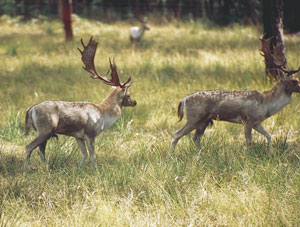 Fallow deer (Dama dama)
Fallow deer (Dama dama)
Fallow deer are one of the most widespread species in the world. They
were originally introduced in the 1830s and today they are found in
five states, with herds established well away from historical release
sites.
Four colour variations are encountered - black, white, common (grey-brown) and menil (light-brown). All have lighter colored under parts. The common fallow have barely visible spots during the winter months, while the menil have spotted coats all year round.
Essentially, grazing fallow can live quite comfortably in open country, but like to have timbered cover available. They are most successful in semi-developed country, along the edge of forested areas or in regeneration areas where first-order regrowth species, such as bracken fern and wattle, are dominant.
The antlers of fallow bucks - not stags - have round beams, which flatten out above the trez (second) tine to form palms with points or spellers along the back edge. The length and width of the palms and the number of points each carries are important factors when assessing trophy quality. A good trophy buck will have an antler length of at least 60cm with a similar spread.
Trophies are usually hunted during the rut (about April each year) when the bucks become vocal and easier to find as they grunt to attract does - not hinds - and warn off would-be rivals. Broken tines are quite common after the rut, as bucks fight fiercely to hold their territories and the females that are with them.
While a rutting buck is usually relatively easy to find, a careful approach is needed. Any does the buck may be holding act as extra eyes and ears to warn of danger.
The best time to hunt fallow is early in the morning and late in the evening, especially along the edge of the bush. In areas that aren’t disturbed, fallow will often develop regular patterns of movement and may be susceptible to a sit-and-wait approach.
Fallow are not large animals and can easily be taken with smaller calibres, which, for practical purposes, begin at the .243 level.
Red deer (Cervus elaphus)
Red deer came to Australia in the mid 19th century, imported from
established game parks in England. Animals were released at various
places in Queensland, Victoria and New South Wales under the protection
of either landholders or the law. Descendants of these releases still
exist - the Queensland herd is probably the strongest. Trapping this
herd for farming dramatically increased the spread of red deer in
Australia and today they exist in areas where they never historically
occurred - not all of them behind wire.
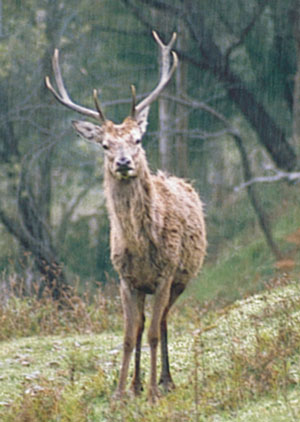 Though essentially a grazing animal, red deer can survive in a variety
of habitats. In Queensland they can be found anywhere from thick jungle
gullies, to open forest with a scrub understorey, or in grasslands.
They seem to prefer semi-cleared country with a good mix of timber,
scrub and grassland - anywhere they can shelter from the weather or
avoid too much hunting pressure.
Though essentially a grazing animal, red deer can survive in a variety
of habitats. In Queensland they can be found anywhere from thick jungle
gullies, to open forest with a scrub understorey, or in grasslands.
They seem to prefer semi-cleared country with a good mix of timber,
scrub and grassland - anywhere they can shelter from the weather or
avoid too much hunting pressure.
A large, attractive deer - a big stag will weigh up to 160kg - the colour of reds varies from light through to dark-brown and some mature stags may appear almost black. All have buff-colored patches on their face, neck and rump.
A good stag will carry antlers with ten to 12 points and a length of about 75cm. Antler configurations vary considerably, but good beams and strong tines are desirable.
Red deer are a herd animal and groups of up to a dozen animals may be seen, generally led by a dominant hind. Stags form bachelor herds during antler growth but these break up with the onset of the rut in March/April when individuals establish and defend territories and any hinds that may be attracted to them.
During the rut, red stags are very vocal. The sound of their roaring carries over a wide area and makes them vulnerable to attention by hunters - although the deer can also be hunted successfully outside the rutting season.
The concept of deer stalking is inextricably and traditionally linked to red deer; probably originating in the Scottish highlands, where the deer were sighted and assessed from a distance and the hunt carefully planned according to the terrain and prevailing weather conditions. Reds have well-developed senses of smell and hearing. Their eyesight is not particularly good, but they are quick to detect any unusual movements. A quiet, steady approach into the wind is necessary.
Calibres for red deer begin with the .270 Winchester. Long shots are often required, especially in open country. A good telescopic sight is essential.
Rusa deer (Cervus timorensis)
Rusa deer were a relatively late introduction to Australia, first
appearing in acclimatisation society records about 1860. They were
released in Victoria and Western Australia but the most successful
release was in New South Wales in 1885, when deer were turned out at
what is now known as the Royal National Park, south of Sydney. The
strength and viability of this herd has been tested during the past 30
years by trapping programs, poaching and bushfires. At present, the
number of animals surviving in the Park is greatly reduced and their
future is far from secure.
On a brighter note, rusa have increased their range - working their way south along the coastal ranges towards the Victorian border. That they survive on the doorstep of suburban Sydney and Wollongong is indicative of the rusa’s adaptability and capacity to persevere against the odds.
Rusa deer also occur on the New South Wales north coast and at a number of locations in Queensland, where they can be hunted on private property.
Though related to sambar deer, rusa are not as large. A big stag may weigh 140kg and the hinds are much smaller. Generally grey-brown in colour, with buff under parts and a light throat patch, the rusa has very coarse body hair that is much sparser than other species.
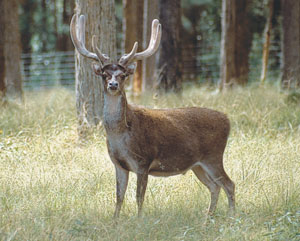 As both grazers and browsers, rusa do quite well in a variety of
habitats, though they seem to prefer a mix of grass and open country
adjacent to thick bush, which they utilise as escape cover and shelter.
As both grazers and browsers, rusa do quite well in a variety of
habitats, though they seem to prefer a mix of grass and open country
adjacent to thick bush, which they utilise as escape cover and shelter.
A rusa stag’s antlers are lyre-shaped with a brow, inner and outer top on each side. The conformation differs from sambar in that the inner or back tine is usually the longer of the two top tines. Antlers with a length or about 70cm are considered excellent trophies, though much longer heads have been taken. With a few exceptions, trophy quality in New South Wales has rarely reached the same level as those taken in New Caledonia - the original source of the NSW release.
Rusa are a herd animal and though quite large mobs will sometimes be encountered, groups of five to six animals probably represent the norm. They’re a vocal species, using a variety of calls to communicate with each other. During the rutting peak, which occurs about July/August, the stags become very vocal, grunting to attract hinds and declare territories, often from a favourite wallow.
A careful approach into the wind using any available cover is essential, especially during the rut. The species can also be stand-hunted in areas where patterns of movement are predictable and the deer relatively undisturbed.
Though many rusa stags have been taken with lesser calibres, the minimum calibre recommended for rusa is the .270 Winchester.
A smaller species of rusa - the Moluccan rusa - exists on some islands off the northern coast of Queensland and in the Northern Territory. Generally speaking, they are not available for trophy hunting.
Axis or chital deer (Axis axis)
Chital deer have the distinction of being the first species imported
into Australia. Dr John Harris, surgeon to the 102nd Regiment of Foot
(NSW Corps) had chital enclosed at Blackwattle Swamp near Ultimo in
Sydney as early as 1803.
Though the fate of these animals is unknown, they were later released in other states, particularly Queensland and Victoria.
The most successful liberation of the species was near Charters Towers in northern Queensland, where William Hann released two pairs in 1886.
Today this herd represents the largest population of chital deer in Australia. The majority live on private property and landholders in the area generally regard the deer as a resource. Guided hunting is allowed on some properties, with trophy fees payable to the landholder.
With their light- to dark-brown coat, white spots, light throat patch, off-white under belly and inner legs, chital are arguably one of the most beautiful deer species in the world. As bright as this coloration seems in the flesh, it helps the deer blend beautifully into the open country, especially when they’re bedded down.
Antlers are typically six-point, with a brow tine - inner and outer top on each. The overall shape includes both wide and narrow V configurations, as well as the more attractive heart shape, where the beams curve inward at the top. Stags with antlers more than 72cm in length are not uncommon. Potential trophy heads need to be carefully checked before a shot is fired, as chital are aggressive fighters and stags with broken tines and/or beams are often encountered.
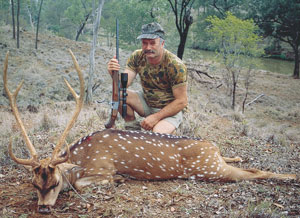 Very much a herd animal, mobs of up to 30-plus chital may be seen,
often at a distance. This usually allows plenty of time to check for
potential trophy heads - but finding a good stag and being able to
stalk him can be two entirely different propositions.
Very much a herd animal, mobs of up to 30-plus chital may be seen,
often at a distance. This usually allows plenty of time to check for
potential trophy heads - but finding a good stag and being able to
stalk him can be two entirely different propositions.
A careful approach is mandatory - working into the wind, making the most of any available cover and keeping a watch for stragglers around the edge - to avoid spooking the herd.
Chital seem to breed all year round, so rutting stags may be found at any time. The best time to hunt is early in the morning or late in the afternoon while they’re feeding. The deer bed down during the hotter part of the day and while they can be approached at this time, they’re generally much harder to find.
Calibres for chital start with the .270 Winchester and a good quality telescopic sight is essential.
Hog deer (Axis porcinus)
Hog deer were released at various locations around Victoria in 1865 but
today their range is limited to areas of south and east Gippsland,
where suitable habitat still exists. To survive, the species need areas
of thick cover - adjacent to freshwater swamps, wetlands and marshes -
where they obtain the bulk of their food requirements. Their current
range encompasses both private and public land, where hunting
opportunities tend to be limited.
The smallest of our deer, a mature hog deer stag in prime condition will weigh about 45kg. They are a uniform brown in colour, with the coat taking on a reddish tinge during the summer months. Older stags are often quite grey in the face.
Antlers are typically six-pointed, with a brow and two top tines on each side. Trophy antlers range from 30 to 40cm in length, though many hunters are happy to harvest any stag carrying six points. Non-typical, multi-tined antlers have been recorded, as have palmated or flattened beams.
An open season is declared each year in April, with a limit of one stag and one hind per hunter. Hunters must be licensed and any deer taken must be tagged.
Finding somewhere to hunt hog deer is problematical for the majority of hunters - especially those from interstate. Access to private property is jealously guarded in most areas, and public land where the deer can be legally hunted is extremely limited.
Even so, opportunities to hunt hog deer do exist. A ballot system run by the Blond Bay Hog Deer Advisory Group gives some hunters access to good habitat each year. Guided hunts are also available and management schemes such as the Para Park Cooperative Game Reserve Limited on Sunday Island give would-be hunters a chance to buy into a program where the opportunity to hunt will arise in time.
In some areas, ‘hoggies’ may be seen in small groups on feeding areas early in the morning or late in the evening - though they quickly become nocturnal if they’re disturbed. When the weather is rough they retreat to heavy cover, but under fine conditions will be found bedded-down close to, or even within, favourite feeding areas.
Hunters need to cover areas carefully, as the deer will move off if alerted by other wildlife such as grey kangaroos, which are common in much of their range. Tree stands over water holes, game trails or feeding areas have proven successful for many hunters - but patience is essential.
The minimum legal calibre for hog deer is a .243 Winchester firing a 100-gn bullet.
Further reading
Good selections of deer-related books are available through various
sources, but the titles listed below are essential additions to any
serious deer hunter’s bookshelf.
- An Introduction to the Deer of Australia by Arthur Bentley;
- The Australian Deer Hunter’s Handbook by Mike Harrison and Ken Slee;
- Walking Them Up by Ken Pearce;
- The Hog Deer by Mayze; and Moore
All books are available from: ADRF Ltd, PO Box 1313, Upwey, Vic 3158. Phone (03) 9752 6613. Email [email protected]
